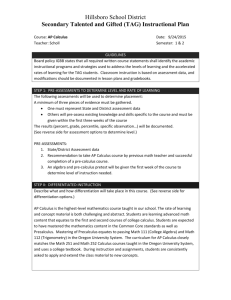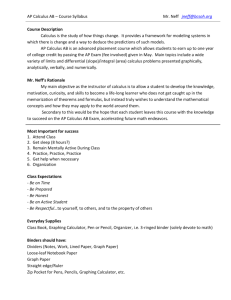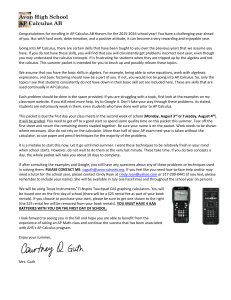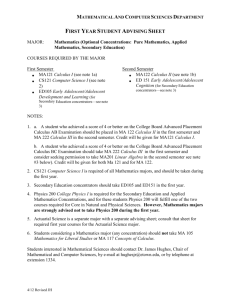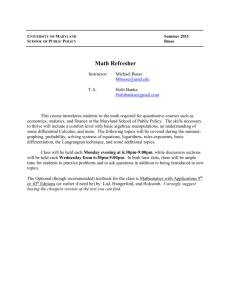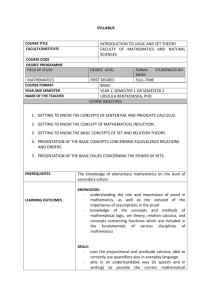The Calculus Reform - University of Georgia
advertisement
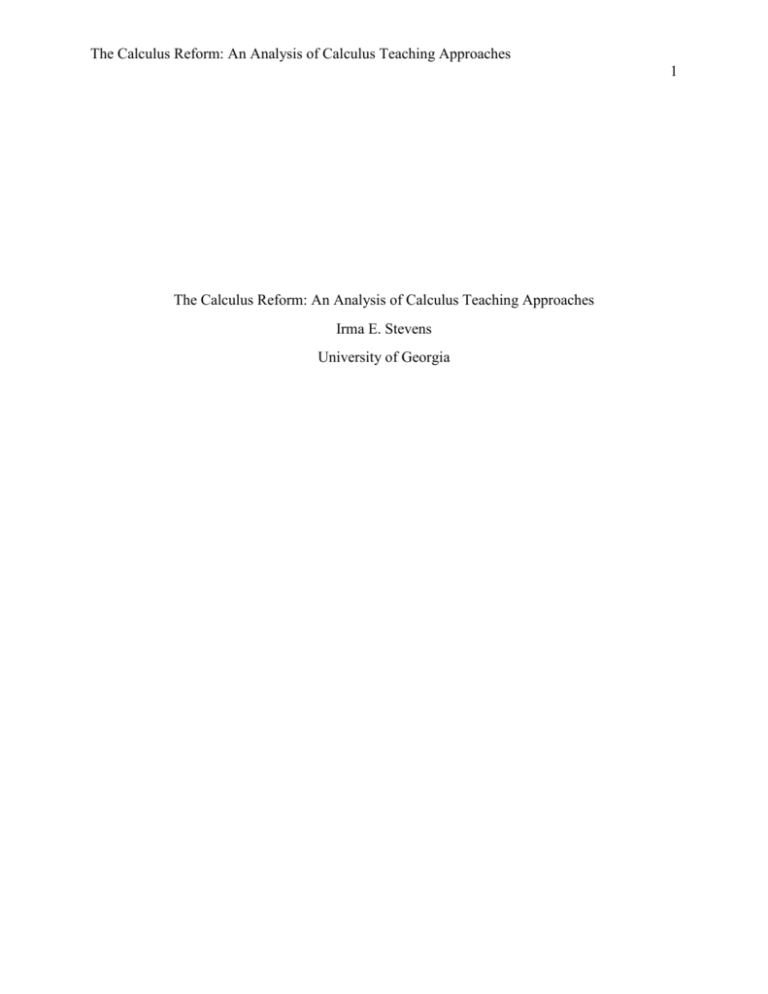
The Calculus Reform: An Analysis of Calculus Teaching Approaches 1 The Calculus Reform: An Analysis of Calculus Teaching Approaches Irma E. Stevens University of Georgia The Calculus Reform: An Analysis of Calculus Teaching Approaches 2 The Calculus Reform: An Analysis of Calculus Teaching Approaches Although Calculus had been around for centuries due to the contributions of a number of mathematicians, technology-driven changes inspired a major university-centered “Calculus Reform Movement” in the early 1990s (Tucker, 1990). These reforms challenged the traditional structure of Calculus instruction, and oftentimes include applications to recent advances in software development. This work aims to examine some of these approaches that mathematicians across the world have developed, implemented, and claimed produce successful results. Although there are undoubtedly more approaches, this article will review five different ones that focus specifically on teaching differentiation and integration: algebraic, graphical, realistic, reinventive, and computer-assisted. Although some of these approaches naturally overlap slightly, the distinct components of each approach will be analyzed, and comparisons and contrasts will be made. Algebraic Approach The approach most closely related to the traditional approach is the algebraic approach suggested by Elk; it still utilizes a lecture-based format but focuses on portraying a logical extension of algebra to transition into Calculus courses. Elk challenges the traditional notions that Calculus is “a new and different form of mathematics from the ones that the student has learned earlier,” the first course in analysis, and distinct from algebra and geometry (Elk, 1998, p. 351). He proposes introducing the underlying algebraic ideas imbedded in the concepts of the derivative and the integral (Elk, 1998). As an example of these underlying algebraic ideas, Elk notes the three situations that involve division by zero: 0/a, a/0, and 0/0, when a is any number not equal to 0. He asserts that differential Calculus gives meaning to the third case (0/0) under the appropriate conditions. The Calculus Reform: An Analysis of Calculus Teaching Approaches 3 From this, he introduces the idea of the change in two y coordinates approaching zero and the change in two x coordinates approaching zero. As the two respective components of the points decrease, the distance between the points decreases and becomes very small. Thus, in the case of the change of these y-coordinate over the change in these x-coordinates would cause both the numerator and the denominator to be zero, resulting in the 0/0 situation. The meaning of the case 0/0 becomes clear with an example. Consider the function f(x)= (x2-4)/(x-2). At x=2, the function reduces to 0/0, and at this point, the function is not defined. In order for the function to be defined at all points, an additional criteria needs to be added; for example, if f(2)=4 were added, it would produce a continuous function for all values of x. Furthermore, any f(2)=b, where b is any number not equal to 4 would produce a discontinuous function. Using this information, Elk presents an algorithm to compute the derivative of a given function (1998, p. 354-355). The algorithm goes as follows: 1. From the given function y=f(x), form f(x+∆x). 2. Subtract f(x) from f(x+∆x) – a difference we call ∆y. 3. Divide ∆y by ∆x and simplify the algebra. 4. Take the limit as ∆x 0. The algorithm results in the equation y’= limx 0 ∆y/∆x’, the definition of the derivative. The key to giving meaning to 0/0 was taking the limit at the end of the algorithm rather than during one of the earlier steps. By doing this, an initially undefined computation can bring about information. Similarly, Elk proposes that integration gives meaning to multiplying infinity times zero. This is because the process of subdividing figures into very small pieces to calculate their individuals means adding together an infinite number of zeros, which is equivalent to The Calculus Reform: An Analysis of Calculus Teaching Approaches 4 multiplying infinity times 0. Elk stresses the importance of noting that this multiplication oftentimes yields a finite product, contrasting the common notions that zero multiplied by anything is zero and that infinity multiplied by anything is infinity. Thus, not only does integration give meaning to infinity times zero, but that meaning is oftentimes finite. This can be seen given the standard definition of an integral: The limit is summing an infinite number of zero terms since the limit of each ∆xi is zero. Many of the following approaches encourage a more conceptual understanding of the ideas of integration and derivatives and often consider applications to the real world or incorporate historical methods in order to develop this conceptual knowledge. Utilizing an algebraic approach may limit the capability of students to extend their knowledge beyond the definitions of derivative and integral in problems concerning real world applications that consider distance, speed, time, and rate. Also, although Elk notes that the integral often seems to give a finite value to the meaning of infinity times zero, it does not explain how that value is reached other than the inclusion of the limit in the standard definition. Furthermore, the definition of the derivative is still structured procedurally, and a concern may be that the step by step instructions do not adequately veer away from traditional instruction. Graphical Approach At a time when the advantages of using computer technology was beginning to surface, David Tall saw its potential and presented a graphical approach to integration and the fundamental theorem. He noted the difficulty of going beyond simple examples when using algebraic methods of summation, and the tediousness and obscurity of interpretation that The Calculus Reform: An Analysis of Calculus Teaching Approaches 5 occurred when using a calculator (Tall, 1986). For these reasons, he presented a process that involves graduating from paper to calculator and then to the graphical interface of a computer in order to obtain insight into the concepts of integration. One of Tall’s main approaches to teaching integration is to have students infer possible functions that describe the behavior observed through the approach taken to solve the integral, be it through the calculator or computer software. Tall notes the difficulty in conjecturing this formula for the area of graph at an interval using averages of upper and lower sums (the trapezium rule) since the approximations viewed cause numerical work to become oppressive quickly when done on paper (1986). As a solution to this, Neil and Shuard cunningly involve their entire class to produce a table of areas from 0 to 1 using the trapezium rule with 10 strips. From the table, students can view common fractions (½, ⅓, ¼, etc.) with the intention of leading them to conjecture that the area under f(x)=xn from 0 to 1 is 1/(n+1) (Neil, Shuard, 1982). Tall suggests using the information obtained from partial sums to conjecture area functions more directly than the results of area calculations. By plotting the successive cumulative area calculation for a function (Tall uses f(x)=x2) (Figure 1) as separate points that represent the area under the graph from x=0 to the current x coordinate using the midordinate rule, the area graph looks like a higher power of x. Students are then to conjecture that it looks about like kx3 for some constant k, and then substitute points to find the value of k (Tall, 1986). Figure 1 The Calculus Reform: An Analysis of Calculus Teaching Approaches 6 Tall’s idea behind the graphical approach is “to concentrate on the ideas rather than the technicalities” (1986, p. 4). For example, in the explanation given above, students are meant to become aware of two ideas: approximations of the area grow closer to the true area when smaller strips are taken, and the results of the graphs display patterns. However, it should be noted that Tall expects students to be able to calculate approximations numerically before graduating to software that will eliminate the need for calculations by hand. With that knowledge base, students can use the software to explore cases such as negative area and develop concepts such as the fundamental theorem graphically. Tall noted that taking negative steps that result in negative area is “rarely done in traditional courses and teachers often suggest to me that it is too difficult for their students” (1986, p. 6). A negative step constitutes taking a point b left of a point a, which would require a step in the negative direction. Graphically, students can understand that a negative step and a positive ordinate results in a negative product, and that a negative step and a negative ordinate results in a positive product. Tall presents a computer simulation that goes beyond a static picture to see the negative step and “sense the growth of the area as the picture develops” (1986, p. 6). By investigating the negative steps, students can uncover all four sign combinations. After observing that smaller strips result in area approximations that come closer to the true area and understanding the signs, Tall believes students now have the background knowledge necessary to find the area between a graph and the x-axis from a fixed point a to a variable x as a function of x. By plotting the cumulative area function for the graph (say f(x)=x) starting at the origin and moving right, and then restarting at the origin and moving left, the graph takes on the recognizable shape of a quadratic function kx2 (Figure 2) (1986, p. 8). Then, The Calculus Reform: An Analysis of Calculus Teaching Approaches 7 by noting that when x=2, y=2, students can conjecture that the area function is x2/2. The same process can be applied to f(x)=x2 and the general pattern of the area under f(x)=xn from 0 to x can be thought of as I(x)=xn+1/(n+1). Figure 2 Tall uses a graphical approach to present the idea of the derivative as well. Gravemeijer and Doorman note the characteristic dynamical aspect of Tall’s graphical approach to teaching these introductory Calculus concepts (1986, p. 113). When teaching derivatives, the graphs present the perspective of a running variable which shows how the dependent variable (y or f(x)) changes when the independent value (x) changes at a constant rate. Students then observe the changes in the dependent variable and the rate of these changes and begin to develop an intuitive idea of these changes in terms of increase, decrease, and gradient. Gravemeijer and Doorman also note that focusing on the gradient of the graph leaves the idea of the derivative as a measure for the rate of change as implicit (1999). The difficulty lies in transitioning from visual imagery discussions to formal mathematical reasoning. Gravemeijer and Doorman conclude that “students interpret a definition that is based on visual imagery as a description, as a model of the picture, instead of a mathematical definition that can be used for formal reasoning.” While Tall proposed the graphical approach to be restricted to a short The Calculus Reform: An Analysis of Calculus Teaching Approaches 8 introductory phase, Gravemeijer and Doorman remain concerned with the proposed disconnect between visual exploration of graphs and formal reasoning (1999, p. 114). Realistic Approach James Kaput developed an approach to Calculus that stresses the relationship between mathematical symbol systems like graphs and everyday realities (Kaput, 1994a; Gravemeijer, 1999). In one of his works, Kaput devotes time to describing an early version of the video system MathCars (now SimCalc MathWorlds) that simulates driving a car through interactive technology (Kaput, 1994, p. 44-60). The idea behind the software is “…to map the phenomenologically rich experience of motion in a vehicle (sights and sounds) onto coordinate graphical and other mathematical notations” by controlling aspects such as time, distance, and velocity which are visible as visual representations and/or graphs (Dubinsky). Gravemeijer and Doorman use the metaphor of the software linking “the gap between the island of formal mathematics and the mainland of real human experience” (1999, p. 114). In the case of MathCars, the software links the everyday experience of motion in a vehicle with formal graph representations. While Elk’s approach built upon knowledge learned in Algebra, Kaput suggests employing a curriculum that introduces the underlying ideas of Calculus (variable rates of changing quantities, the accumulation of those quantities, the connections between rates and accumulations, and approximations) in early grades (Kaput, 1997). The idea is to build up concepts gradually to the mathematics found in Calculus. In order to develop curriculum, he considers the implications of history and desires to “…look closely at the origins of the major ideas of the Calculus for clues regarding how Calculus might be regarded as a web of ideas that should be approached gradually, from elementary school onward in a coherent school The Calculus Reform: An Analysis of Calculus Teaching Approaches 9 mathematics curriculum” (1994, p.2). Overall, Kaput mentions that mathematicians in the past developed their ideas gradually based on real world experiences. With this in mind, Kaput is suggesting a three part method to developing the ideas of derivatives and integrals. Dubinsky outlines the three steps Kaput mentions (Dubinsky, p.5-6). First, at an early age, students should be able to represent quantities such as temperature, velocity, acceleration, time, and distance as geometrical objects (i.e. lines and rectangles). Secondly, teachers incorporate the video technology described above in order to conceptualize continuous phenomena. Lastly, students discuss and move towards firm, logical foundations of the principles of Calculus. Dubinsky, Gravemeijer, and Doorman are critical of Kaput’s approach. While Dubinsky seems to support the actual software that Kaput is promoting, he also notes that using the same methods as the historians may only make teachers aware of the difficulties students face when learning Calculus without a solution to dealing with those difficulties (p. 12). Gravemeijer and Doorman note that Kaput’s concept of a mathematical system as distinct from everyday-life experiences results in software that takes the historically developed symbol system for notation as a point of departure; instead of keeping the two distinct, they say that others try to help students either reinvent or develop the symbol system themselves (1999, p. 114). Dubinsky has a similar idea when he writes that Kaput seems to emphasize the idea that notation must precede, if not dominate, conceptual understanding. He then presents an alternative view, encapsulation, in which construction of concepts comes before development of notation. It is the idea that one first encapsulates a process into an object and then develops a notational scheme that can be connected to the concept. In order to construct these mental objects, he recommends for students to use technology that will enable them to write programs that accept input functions and output The Calculus Reform: An Analysis of Calculus Teaching Approaches 10 the functions as objects, providing “the opportunity to perform actions on certain concepts which are to be the referents of notational symbols” (p. 13). Guided Reinvention Gravemeijer and Doorman consider the Dutch approach of Realistic Mathematics Education (RME) as a method of using context problems as “models for” instead of “models of” mathematical reasoning (1999, p. 111). Instead of a procedural or entirely graphical approach, which the authors believe may leave students unable to understand the whole picture or unable to connect concepts to formal mathematics, this method suggests that teachers employ guided reinvention, often by considering the historical origins of the concepts. The idea is to keep the gap between where the students are and what is being introduced as small as possible by designing a hypothetical learning trajectory for the students to be able to reinvent formal mathematics. While Kaput used a historically based approach as well, the perspective shifts from considering notation and human experience as distinct to viewing it as a development from one to the next; it is not comparing a ready-made system with real world experiences but rather a reinventing process of the system. The process of guided reinvention places the emphasis on the character of the learning process over the invention. The idea is for students to develop their own private knowledge and understanding individually, with guidance, and not answers, from the teacher. The idea of progressive mathematization that Gravemeijer and Doorman present stems from a combination of Treffers’s idea of horizontal and vertical mathematization (Treffer, 1987). Horizontal mathematization is the process of describing a context problem in mathematical terms. Vertical mathematization is mathematizing one’s own mathematical activity; students reach higher levels of mathematics through this. The Calculus Reform: An Analysis of Calculus Teaching Approaches 11 By using context problems, students develop informal, context-specific solution strategies that are meant to guide them to generalizations. These generalizations become models for mathematical reasoning. In the case of RME, context problems are defined as “problem situations that are experientially real to the student” (Gravemeijer, 1999, p. 127). As an overview, in order to develop Calculus concepts, contextual problems consist of modeling problems about velocity and distance. Using this method to understand integrals, students initially develop discrete approximations of a function denoting varying velocities and distances. The resulting inscribed discrete graphs later become continuous and the model for formal mathematical reasoning. The act of summing the discrete intervals made on the graph or noting the differences in the increments are the reifying processes, while the integral and derivative become the mathematical objects. As the students work through the problem, they will likely experience a nonlinear learning process that will end with a result between a process and an object. The goal for the teacher is to emphasize that “the underlying process is an integral part of the mathematical object that is developed” (Gravemeijer, 1999, p. 123). The following presents the reification process of the integral and then the derivative. Instead of simply being told that the area of the graph coincides with the total distance covered over a period of time, students develop the ability to model and conceptualize motion through representations and approximations. In order to accomplish this, students are first presented with the story of Galileo. He presumed that a free-falling object would move with a constantly increasing velocity. Students are asked to graph the discrete approximation of that motion and then asked to discover the distance covered by the object (Figure 3) (Gravemeijer, 1999, p. 125). Students solve these discrete approximations and are then expected to connect the area of the discrete graph with the area of a continuous graph such as s(t)=5t2. This is done by presenting The Calculus Reform: An Analysis of Calculus Teaching Approaches 12 Figure 3 the students with s(t) as (t * 10t)/2 instead; the students see this as the area of a triangle (with base t and height 10t). From this, they discover the quadratic relationship between time and distance, which is what Galileo used to test the aforementioned hypothesis. The next step is to progressively rediscover differential Calculus. This is done by determining velocities from distance-time graphs and formulas. As students work through examples, the model they have developed for reasoning through the problems will begin to function as a model for reasoning arbitrary function as well as standard algebraic functions. At this point, the teacher should shift from everyday-life context problem to a focus on mathematical concepts and relations. This shift will be possible for the students when they are able to develop a framework that enables them to view the problems mathematically (Gravemeijer, 1999). This approach aims for students to develop a conceptual understanding of the concept smoothly as they are guided from contextual problems to a focus on mathematical concepts and relations. However, the formal definition, containing a limit and based on summing the areas of infinitely many rectangles, is not introduced; only the geometric area under a curve is discussed. Although the jump from true area to approximated area may not be a substantial one, it is one to consider if students are expected to be able to understand the formal definition of an integral. The Calculus Reform: An Analysis of Calculus Teaching Approaches 13 Computer-Assisted Approach Lang presents the development of computer-assisted instruction (CAI) in China in 1999. Although technology has developed significantly since the article was written, it presents the idea of implementing laboratory courses to foster “the scientific exploratory spirit” of the undergraduate Calculus students at an engineering school (Lang, 1999, p. 401). Lang emphasizes the role of the computer as a tool, not a replacement for brainpower, and notes that good problems should encourage students to think deeply. The goal is for the lab to be continuously in development, and Lang encourages teacher collaboration to develop good problems. Since it is assumed that the students will be taught the formulas for integrals and derivatives in a more traditional setting in the classroom, the lab is the time for students to be able “to understand concepts and pursue novelty in mathematics” (Lang, 1999, p. 402). The idea is to shift the students away from memorizing the proofs of a theorem to truly understanding the theorem. Therefore, the lab is a time for students to find “explanations” instead of “proofs” for the definitions they have learned. Lang notes that good explanations include important thoughts of proof, and thus a students’ understanding of a mathematical theorem is not necessarily weakened by a shift towards a concentration on explanation over proof. The following is an example of a computer experiment to develop the understanding of the relationship between functional increment and differential (Lang, 1999, p. 402): 1. For f(x)= x when x0=64, ∆x = -1, find the true increment and its differential approximation, make a comparison, and calculate the relative error when using the approximation. The Calculus Reform: An Analysis of Calculus Teaching Approaches 14 2. For g(x)=x100 when x0=1, calculate the increment and differential approximation, make a comparison and calculate the errors at ∆x=0.03, ∆x=0.003, and ∆x=0.0003, respectively. By calculating and comparing functional increments and differentials of various functions that result from different increments for different values of the independent variable, students can discover the accuracy of the approximation. Students should note the differential becomes a good approximation of the function increment when the sizes of the increment of the independent variable are smaller. The idea of the labs that Lang mentions is to shift the students away from the memorization of definitions and proofs and towards an ability to explain these definitions. Although only a couple examples of questions posed to students in the lab were presented in the article, the questions seem to focus on either exploring the limits of the procedures used to calculate integrals and derivatives or identifying patterns in relationships. While this knowledge is helpful in understanding the processes, it does not suggest a change in the way the definitions of integrals and derivatives are presented to the students in the lecture portion of the classroom or hint towards any contextual problems considering rate, velocity, distance, or time. Conclusion The five aforementioned approaches resulted from the Calculus reform of the 1990s as an effort to challenge traditional Calculus instruction and to aid students in developing a more conceptual understanding of the meanings of differentiation and integration. Although each approach presented various strategies of the concepts to students, each strived to move beyond procedural fluency. The differing methods incorporated students’ prior knowledge, historical influence, real-world contexts, graphical imagery, and computer-enhanced computations. The Calculus Reform: An Analysis of Calculus Teaching Approaches 15 References Dubinsky, E. (n.d.). Reaction to James Kaput's paper 'Democratizing access to calculus: New route to old roots'. Informally published manuscript, Purdue University, Purdue University, Lafayette, IN. Elk, S. (1998). Is calculus really that different from algebra? A more logical way to understand and teach calculus. International Journal of Mathematical Education in Science and Technology, 29(3), 351-358. Gravemeijer, K., & Doorman, M. (1999). Context problems in realistic mathematics education: A calculus course as an example. Educational Studies in Mathematics, 39(1-3), 111-129. Kaput, J. (1994). Democratizing access to calculus: New routes to old roots. Mathematical thinking and problem solving, 77-156. Kaput, J. (1994a). The representational roles of technology in connecting mathematics with authentic experience. Didactics of Mathematics as a Scientific Discipline. Kluwer Academic Publishers, Dordrecht, 379-297. Lang, X. (1999). CAI and the reform of calculus education in China. International Journal of Mathematical Education in Science & Technology, 30(3), 399-404. Neil, H., & Shuard, H. (1982). Teaching calculus. Blackie. Tall, David. (1986) A graphical approach to integration and the fundamental theorem. Mathematics Teaching, Vol.11 . pp. 48-51. ISSN 0025-5785. Treffers, A. (1987) Three dimensions, a model of goal and theory description in mathematics education: The wiskobas project. D. Reidel, Dordrecht. Tucker, T. (1990). Priming the calculus pump: Innovations and resources. Washington, DC: MAA.


